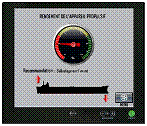Thrustwatch@sea ™

A smart investment for fuel economy control
The Marine Environment Protection Committee of the International Maritime Organization adopted the 2012 Guidelines for the development of a Ship Energy Efficiency Management Plan (SEEMP) that entered in force on January 1, 2013 – cf. MEPC 1 / Circ. 683.
The purpose of this SEEMP is to establish a mechanism to improve the energy efficiency of ship’s operation, in order to reduce fuel oil consumption and reduce associated emissions of greenhouse gases.
SEEMP is mostly based on record-keeping, manually performed by the crew. Beyond the regulation aspect of SEEMP, any reduction of fuel oil consumption will cut bunkering costs.
THRUSTWATCH@SEA® is a real time physical monitoring system of the efficiency of the propulsion system, based on the continuous measurement of the thrust, the speed of the vessel and the power on the propeller(s) shaft line(s). The global efficiency of the propulsion is indeed given by the ratio of these figures.
Real time indicators, as simple as Green-Yellow-Red types, are displayed on the bridge, after threshold values had been determined, according to:
- Loading of the ship (trim optimization)
- Meteorological conditions (optimization of the heading in accordance with swell and wind)
- Fouling state of the hull

PRINCIPIA has successfully validated a direct thrust acquisition system based on measurement of micro-buckling of the thrust bearing(s) foundation, with strain gauges, and preliminary finite element calculations.
This system can be installed on board vessels already in operation.
Thrust measurement methodology was validated for propulsion systems where thrust bearings are mounted as independent units on propeller shaft lines, such as on board large passenger ships, off-shore vessels, navy ships etc.
Validation is in progress for vessels with low speed engines, where the thrust bearing are integrated within the propulsion engines, as found on most of the VLCC and container ships.
